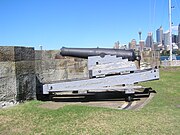| Ordnance ML 8 inch gun | |
|---|---|
 54 cwt gun | |
| Type | Naval gun |
| Place of origin | United Kingdom |
| Service history | |
| In service |
1825- (50 cwt version) 1838- (65 cwt version)[1] |
| Used by | Royal Navy |
| Production history | |
| Designer | General Miller, R.A.[2] |
| Unit cost | £172 [3] |
| Specifications | |
| Mass |
7,280 pounds (3,300 kg) (65 cwt version) |
| Barrel length |
9 feet (2.7 m) (65 cwt version) |
|
| |
| Shell |
49 pounds 14 ounces (22.6 kg) (Common shell); |
| Calibre | 8.05-inch (204.5 mm)[4] |
| Muzzle velocity |
1,464 feet per second (446 m/s) (49 lb 14 oz Common shell); |
| Maximum firing range | 3,300 yards (3,000 m)[7] |
The ML 8 inch shell guns of 50 cwt, 54 cwt and 65 cwt [8] were the three variants of British cast iron smoothbore muzzle-loading guns designed specifically to fire the new generation of exploding shells pioneered in the early-mid nineteenth century by Henri-Joseph Paixhans.
Design[]
The idea behind a gun that could fire spherical exploding shells but not solid armour-piercing shot was that large projectiles capable of carrying a large explosive filling could be fired from comparatively light guns:[9] the 8-inch 68 pounder gun intended to fire solid shot weighed 95 cwt (4,826 kg) compared to the 65 cwt (3,302 kg) of the typical 8-inch shell gun.
This was a "chambered" gun, meaning that the area at the breech-end of the gun where the gunpowder propellant charge burned was not of the same cylindrical section as the gun bore itself. The chamber was of the "Gomer" conical pattern, tapering towards the rear, typical of mortars of the day. This was necessitated by the need to minimise the gun's weight while still allowing it to fire a relatively heavy shell : it ensured that the thickest amount of metal surrounded the point of maximum pressure on firing, at the rear of the chamber. However, mortars fired at high elevations, allowing the powder charge to naturally seat into the coned rear end of the chamber, whereas guns such as this fired on a relatively flat trajectory, leading to the powder charge sitting on the bottom of the chamber. Hence in sea service using smaller "reduced" charges such as in short-range actions this slowed the rate of fire as precautions had to be taken to ensure that the powder charge remained correctly positioned within the chamber until firing, to avoid a misfire.[10]
Deployment[]
The early 6-foot 8½ inch 50-cwt version was deemed "too light and short for armament of great ships of war" and the 9-foot 65 cwt version of 1838 was the model typically deployed on British warships "of all rates and classes".[1]
They were superseded by the new generation of rifled muzzle-loading guns in the 1860s, and 65 cwt versions were converted to RML 64 pounder 71 cwt guns via Palliser's method.
See also[]
Surviving examples[]

- 65 cwt gun at Fort Denison, Sydney, Australia
Notes and references[]
- ↑ 1.0 1.1 Douglas, 1860, pages 184-185
- ↑ "General Miller, R.A. has had the credit of the introduction into our service, but the proper use of shell-guns was first pointed out by General Paixhans, in his Nouvelle Force Maritime, published in 1822, and they were adopted by the French before 1824". page 42 in Owen "The principles and practice of modern artillery"
- ↑ Complete cost of gun, carriage, slide and appurtenances. Douglas, 1860, page 339
- ↑ 4.0 4.1 4.2 Table I, page 525 in Owen "The principles and practice of modern artillery"
- ↑ Table VIII, page 531 in Owen "The principles and practice of modern artillery"
- ↑ With a charge of 10 lb gunpowder. Table VIII, page 531 in Owen "The principles and practice of modern artillery"
- ↑ 3300 yards at 16° elevation, firing 51-pound shell with 10 pounds gunpowder propellant. Douglas, 1860, page 580, Table V.
- ↑ "Smooth-bored shell guns from which solid shot cannot be fired are designated by the calibre in inches and the weight of the piece". page 39 in Owen "The principles and practice of modern artillery". 1 cwt (abbreviation for hundredweight) = 112 pounds = 51 kg.
- ↑ page 42 in Owen "The principles and practice of modern artillery"
- ↑ Douglas, 1860, pages 186-187
Bibliography[]
- General Sir Howard Douglas, "A Treatise on Naval Gunnery". Fifth edition, revised. published by John Murray, London, 1860
- Lieutenant-Colonel C H Owen R.A., "The principles and practice of modern artillery". published by John Murray, London, 1873
External links[]
| Wikimedia Commons has media related to ML 8 inch shell gun. |
| |||||||||||||||||||||||||||||||||||||||||
The original article can be found at ML 8 inch shell gun and the edit history here.